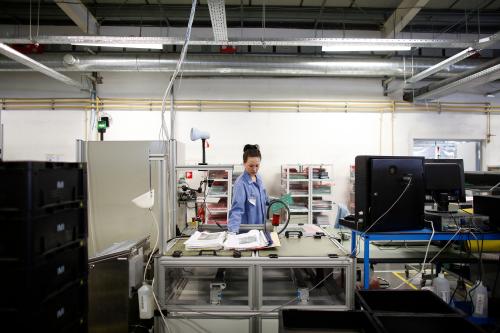Just as the economies of the Western Balkans were looking to sustain a recovery from the shock of COVID, the region now faces a new combination of challenges. The war in Ukraine, the resulting sharp increase in energy prices, together with a slowdown in global growth and tightening of global finances, are weighing heavily on economic performance in all six economies—Albania, Bosnia and Herzegovina, Kosovo, Montenegro, North Macedonia, and Serbia—despite a strong start in the first six months of 2022.
In fact, during the first half of 2022, employment levels reached historical highs in several countries. The employment rate for the region now averages 46 percent, a 3-percentage point increase compared to a year ago. All sectors contributed to the job market recovery, with services (including tourism) playing an especially strong role. As a result, labor shortages have emerged as a key concern highlighted by businesses across the region.
The unemployment rate in the Western Balkans also declined to a historic low of 13.5 percent by mid-2022, bringing around 151,000 people out of unemployment into jobs. Encouragingly the broad-based recovery in the labor market also benefitted vulnerable groups and lifted an equivalent number of people out of poverty. Youth unemployment also reached a record low of 27.1 percent, while labor force participation among women increased to 53.0 percent by mid-2022 (up 2.6 percentage points).
The region heads into another storm
Figure 1. Growth rates in the Western Balkans have been revised downward again since spring 2022 (Real growth, percent)
Source: World Bank staff calculations
However, the region is now confronted by a series of adverse shocks. The six countries are close to the eye of the storm in terms of the global energy crisis, and the war in Ukraine, but without the protective umbrella that advanced economies and countries within the European Union are able to provide to their vulnerable populations. Higher energy and food prices have pushed inflation to levels unseen for decades, eroding purchasing power and business confidence. High inflation affects the less well-off relatively more than other income groups, and that could erase the recent gains in poverty reduction. The region’s export boom has begun to slow, just as import costs have sharply increased due to the higher commodity prices, widening current account deficits sharply and putting a pressure on currencies and foreign exchange reserves. More recent data also suggests that the labor market is beginning to cool with employment growth slowing amid high inflation and increased uncertainty. And monetary tightening needed to tame inflation is pushing up financing costs and weakening demand, including in the region’s main trading partners.
This heady combination of supply and demand shocks weighs heavily on the region’s outlook, keeping inflation high and dampening consumer and investor confidence. Economic activity is slowing sharply in advanced economies, especially in the Eurozone, which is a key source of demand for Western Balkans goods and services, and a source of investment and remittances. As a result, growth in the Western Balkan countries has been further revised downward for 2023 (Figure 1).
Looking beyond the crises
Governments are facing acute fiscal pressures due to a combination of energy relief needs and higher financing costs. This occurs at a time when fiscal buffers are already depleted due to COVID policy support and financing conditions have tightened. Yields on outstanding Eurobonds issued by Western Balkan countries widened noticeably in 2022, with some of them pushing close to as high as 10 percent. Fiscal risks will need to be closely monitored as energy generation and distribution firms struggle to finance their operations and in several countries are prevented from fully passing on higher costs to end users. Fiscal deficits are expected to widen, and public debt to increase.
Figure 2. Structural reforms are needed to boost potential growth in the Western Balkans (GDP growth, percent)
Sources: Penn World Tables; U.N. Population Prospects; World Bank; World Bank, WDI. Note: ECA = Europe and Central Asia; EMDEs = emerging market and developing economies; WBK = Western Balkans. Shaded area indicates forecasts. GDP weights are calculated using average real U.S. dollar GDP (at average 2010-19 prices and market exchange rates) for the period 2011-19.
In the short term, governments should prioritize policy support to the vulnerable, ensuring that measures are targeted and time-bound to minimize fiscal risks. But at the same time, with limited fiscal space, no-regret reforms that would boost medium-term growth at limited fiscal cost should be a priority. Given intense headwinds to long-term growth prospects, it will be critical for economies in the Western Balkans to advance structural reforms and accelerate economic transformation. Convergence with European peers is only possible for the Western Balkans if the rate of potential growth is increased.
At a time when public sector resources are scarce, it would be appropriate to prioritize reforms with limited fiscal cost that would serve to accelerate potential growth and convergence over the medium term (Figure 2). This would include measures to raise standards of governance, including digitalization, increase the level of market competition, remove entry barriers to business, and increase retention and reinvestment among foreign investors to boost factor productivity, as well as improve skills and reduce barriers to female labor force participation. The ongoing crisis also underpins the importance of accelerating the green transition in the region away from volatile hydrocarbons toward cleaner electricity generation, as well as greener production, finance, and consumption patterns.











Commentary
The Western Balkans heading toward another storm
November 16, 2022